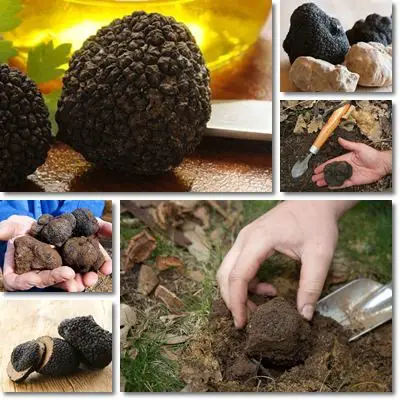Truffles are one of the most expensive edible mushrooms, fetching hundreds to thousands of dollars per pound, and a staple in high-end restaurants and cuisines around the world. There are actually dozens of different species which range in color, size and even flavor profile, with black truffles being the most popular and white truffles from Southern Europe the most expensive. Given the exorbitantly high prices practiced, intake is infrequent as well as limited to fairly small amounts (shavings or fine slices), which means there is little overall nutrition to derive from truffle consumption. However, this particular mushroom species is an excellent source of quality protein, low in fat and contains both saturated and Omega-6 fatty acids. Aromatic compounds in truffles hold antioxidant, antibacterial and anti-inflammatory benefits as well as immuno-modulating and even antitumor properties.
What are truffles? True truffles are edible mushrooms belonging to the Tuber genus. Unlike your typical mushroom, they grow underground which means harvesting them actually means having to dig them up (hence the name ‘Tuber’). They are mostly sourced from the wild and harvesting seasons vary according to species. For example, the black truffle (Tuber melanosporum) is in season from October-November till early December. The white truffle (Tuber magnatum) harvest season starts in October-November and may last till late fall to early winter. Summer truffles (Tuber aestivum) are in season from May till August. Truffle hunting requires the help of dogs trained to detect the mushrooms by their particular smell, owed to a complex of aromatic compounds. In the past, pigs were used as well, but because they lacked discipline and would eat the mushrooms, they are now avoided.

Why are truffles so expensive? For once, they are rare, not to mention difficult to forage for. Yearly rainfall and other weather variations have a direct and significant impact on yields. Prices can easily double during years when production is low. Harvesting requires using dogs especially trained to unearth the tuberous mushrooms. Moreover, truffles are mostly harvested from the wild. While cultivation is possible, it is not currently as profitable as sourcing from the wild. Also, the rarer and bigger the truffle, the more expensive it is. Right now, the white truffle (Tuber magnatum) is the most expensive variety. For the most part, specimens bigger than 30-60 grams fetch the highest prices. Some of the most expensive specimens ever sold weighed over 300 grams and were valued upward of 330.000 dollars. Truffles weighing 1 kg and almost 2 kg each have been unearthed and, at these sizes, fetched some of the most impressive prices.
How to grow truffles. On the one hand, the mushrooms require specific growing conditions: neutral to alkaline, calcareous soils, plentiful rainfall and only grow in association with certain tree species (oak, birch, hazel, beech, poplar) – so this alone is a significant investment. On the other hand, it takes years to reach a level of production that can offset investment costs and produce profit. That is, assuming the trees sustaining a truffle farm are not affected by disease. Harvesting requires dogs especially trained to unearth the mushrooms, not to mention the fact that truffles are perishable and need to get to the end consumer in a limited amount of time from their harvesting. So while you can definitely grow truffles, it’s not the easiest, fastest, nor the cheapest business venture.
What do truffles look like? There are dozens of different species. The general appearance is that of a rounded or irregular-shaped, boulder-like, underground fruiting body. Depending on the species, skin color may range from creamy white to pale yellow, tan, light brown, dark brown, purple-brown or black. The skin can be smooth, lobed, furrowed, bumpy or with wart-like projections. The flesh may be one color, marbled or mottled, with narrow veins running through it. As a truffle ages, its flesh may change color.

1) The black truffle or the Perigord truffle (Tuber melanosporum) is rounded or irregular, with a dark-brown to black skin covered in small, slightly pointed bumps (to me, it’s somewhat reminiscent of a dark jackfruit skin). The flesh starts out white but darkens as the truffle matures. The flesh also has white or tan streaks in a vein-like pattern.
2) The white truffle (Tuber magnatum), the most expensive species right now, occurs naturally throughout southern Europe. It has an irregular shape and smooth, knobby skin that ranges in color from cream to pale yellow to tan. The flesh is a pale cream color or darker, a medium to rusty brown, but with fine, narrow white veins that give it a marble-like appearance.
3) The burgundy or summer truffle (Tuber aestivum) has a dark brown to black skin covered in small, rough, wart-like bumps. The flesh is hazel in color (light to yellowish brown), with narrow white veins.
What do truffles taste like? The flavor profile includes woody, herbaceous, musky, wet earth or wet forest bed notes with a light peppery taste and a faint bitter aftertaste. The most aromatic truffles are said to also possess a dried fruit or nutty aroma or mild, bitter cocoa flavors. Black truffles are nuttier and stronger-tasting, whereas white truffles are just as savory, but milder, with a slightly pungent aroma or a garlic-like hint of flavor to them. The odor is much more pregnant compared to the taste itself and truffle flavors tend to linger in the mouth rather than fade away quickly. It’s really an acquired taste, but does give a pleasant, rich flavor to most dishes it’s added to, whether it’s pasta, risotto or eggs.
Nutrition facts
There is little information available regarding the nutritional value of black and white truffles, despite them being a culinary delicacy and constant presence in high-end cuisine. The following nutrition facts are known for truffles:
- 60% carbohydrates (per dry matter)
- 20-27% protein
- 3-7.5% fat (both saturated and unsaturated fat)
- 7-13% fiber
- 2-5% ascorbic acid, or vitamin C
- 9.7–25.5% phosphorus
- good source of potassium, calcium, magnesium, manganese, iron, copper, zinc, sodium, silicone, aluminum.
- more than 200 volatile organic compounds that contribute to aromatic profile and therapeutic properties
Source 1: Kagan-Zur V, Roth-Bejerano N. Desert truffles. Fungi. 2008;1:32–37.
Source 2: Hussain G, Al-Ruqaie IM. Occurrence, chemical composition and nutritional value of truffles: an overview. Pakistan Journal of Biological Sciences. 1999;2(2):510–514.
Source 3: Wang S, Marcone MF. The biochemistry and biological properties of the world’s most expensive underground edible mushroom: truffles. Food Research International. 2011;44(9):2567–2581.
Potential benefits
- Antioxidant benefits: scavenging free radicals and preventing oxidative stress linked to chronic disease.
- Anti-inflammatory and antibacterial properties from water and alcohol extracts.
- Anticancer (cytotoxic) activity against several cancer cell lines.
- Source of quality protein, containing sulfur amino acids such as methionine, cysteine, tryptophan and lysine.
- Low energetic value (truffles are low in calories and provide a low caloric intake as a result of limited intakes).
- Some species have immune system-boosting properties thanks to good vitamin C amounts.
- Potential, but minor benefits for bone health (phosphorus content in some Tuber species helps strengthen bones and teeth).
- Varied mineral profile with tonic, restorative properties.
- Has no cholesterol, but is a good source of dietary fiber, providing minor benefits for cardiovascular health.
What are the side effects?
Side effects associated with truffle consumption are extremely rare. This is mostly owed tot the fact that the mushrooms are consumed in limited amounts, infrequently and by a small percentage of the population, compared to more common and readily available options such as portobellos, crimini, button mushrooms or porcini. In rare instances, allergic reactions are possible as well as digestive discomfort, if larger amounts are consumed. Given usual intakes, heavy metal contamination is unlikely.
